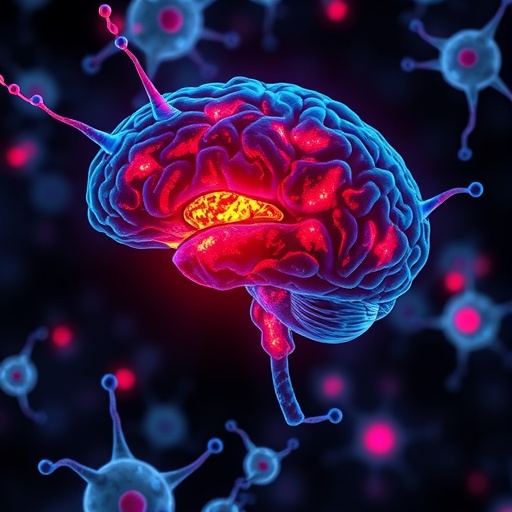Sepsis-associated encephalopathy is a severe and often fatal complication of systemic infection, characterized by acute brain dysfunction including delirium, cognitive impairment, and long-term neurological deficits. The pathogenesis of SAE has been largely obscure, but accumulating evidence implicates neuroinflammation and altered synaptic homeostasis as central factors. Through meticulous cellular and molecular interrogation, Wu, Zhang, Yu, and colleagues have elucidated that small intestinal γδ T17 cells actively promote SAE pathophysiology, thus opening new avenues for therapeutic exploration aimed at modulating peripheral immune influences on the brain.
γδ T cells are a unique T cell subset distinguished by their T-cell receptor, which is composed of γ and δ chains rather than the conventional αβ configuration. These cells are abundant in barrier tissues such as the gut and are known for their rapid and robust cytokine production, particularly interleukin-17 (IL-17). The relevance of γδ T17 cells, a subset specialized in IL-17 secretion, has predominantly been studied within the context of mucosal immunity and inflammatory disorders. However, their role in brain disease, especially in systemic inflammatory states like sepsis, had remained enigmatic until now.
.adsslot_gEpIB3moqL{ width:728px !important; height:90px !important; }
@media (max-width:1199px) { .adsslot_gEpIB3moqL{ width:468px !important; height:60px !important; } }
@media (max-width:767px) { .adsslot_gEpIB3moqL{ width:320px !important; height:50px !important; } }
ADVERTISEMENT
The researchers employed a sophisticated murine model of sepsis to investigate how small intestinal γδ T17 cells influence SAE progression. Intriguingly, male mice exhibited a distinct exacerbation of neurological symptoms, concomitant with an increase in these gut-resident γδ T17 cells. Further analysis revealed that these cells activate the stimulator of interferon genes (STING) pathway, a central mediator of innate immune sensing of cytosolic DNA, which in turn upregulates the expression of complement component C1q—a protein classically known for its role in synaptic pruning during neural development and disease.
Microglia, often regarded as the brain’s resident macrophages, are pivotal players in shaping neural circuits by pruning synapses during development and in response to injury or disease. The newly characterized STING/C1q axis instigated by γδ T17 cells influences microglial behavior, skewing them towards heightened synaptic pruning activity. This excessive pruning is believed to underlie the synaptic dysfunction observed in SAE, which contributes to the cognitive and neurological impairments typical of the syndrome.
This finding establishes a mechanistic framework linking peripheral immune triggers in the gut to central nervous system pathology through a detailed immune signaling cascade. It underscores the underappreciated role of intestinal immune cells in modulating brain function during systemic inflammatory insults and highlights the brain-gut axis not merely as a neurochemical communication pathway but as an immunological highway.
Further, the male-specific exacerbation of SAE described by Wu et al. adds a critical dimension to our understanding of sex differences in immune responses and neuroinflammation. The study’s data suggest that male mice, compared to females, possess a distinct γδ T17 cell profile or activity level that predisposes them to more severe neuroimmune consequences during sepsis. This sex bias could reflect differences in hormonal regulation of immune cell function or genetic and epigenetic programming and raises important considerations for personalized therapeutic strategies.
The authors’ advanced use of immunohistochemistry, single-cell sequencing, and functional assays paints a comprehensive picture of this gut-brain immune axis. Their methods allowed precise delineation of γδ T17 cell migration, activation status, and cytokine milieu alongside microglial phenotypic changes after sepsis induction. This multi-modal experimental approach strengthens the causal link between small intestinal immune responses and brain microenvironment alterations.
Importantly, the discovery that the STING pathway is centrally involved offers a tantalizing therapeutic target. STING modulates expression of various inflammatory mediators and is implicated in multiple autoimmune and neurodegenerative diseases. Pharmacological modulation of STING signaling or downstream components such as C1q expression could potentially mitigate the detrimental microglial synaptic pruning that drives cognitive deficits in SAE.
Beyond clinical implications, this research redefines the broader conceptual landscape of neuroimmunology by illustrating how gut-derived immune cell subsets can deliberately influence the central nervous system’s immune milieu during systemic insults. It invites further exploration of other gut-resident immune populations and their potential roles in various neuropsychiatric and neurodegenerative conditions, particularly those associated with systemic inflammation or gut dysbiosis.
Moreover, the study’s detailed interrogation of cell signaling pathways invites a deeper investigation into the molecular triggers that initiate γδ T17 cell activation in the gut following sepsis. Understanding upstream signals—be they microbial products, tissue damage-associated molecules, or metabolic cues—may help identify early intervention points to curb the maladaptive neuroimmune cascade.
The intersection of complement biology with STING activation in microglial synaptic pruning also invites a renewed focus on how innate immune effectors traditionally studied in peripheral infections contribute to central nervous system dysfunction. Complement components, especially C1q, have long been associated with neurodegenerative diseases such as Alzheimer’s, and this study links them to acute neuroinflammatory contexts mediated by peripheral immunity.
Additionally, the authors’ emphasis on sex differences in immune-neural interactions highlights the importance of including both sexes in preclinical research, which historically skewed heavily towards male models or failed to address sex as a biological variable. The sexual dimorphism observed in the present study could illuminate broader principles governing immune-mediated neural pathology, with implications extending to human sepsis survivors who often exhibit sex-specific recovery trajectories.
While this study was conducted in murine models, its implications for human health are profound. Sepsis remains a leading cause of mortality worldwide, and SAE contributes significantly to post-sepsis morbidity. Current management focuses largely on supportive care, with no targeted therapies to prevent or reverse brain dysfunction. Insights into gut immune contributions to SAE pathophysiology may herald novel interventions that leverage immune modulation at peripheral sites to protect the brain.
Future research building on these findings may explore therapeutic strategies such as γδ T17 cell depletion, STING pathway inhibitors, or complement-targeted treatments to preserve synaptic architecture in the face of systemic infection. Additionally, microbiota-targeted therapies could modulate the intestinal immune environment to beneficially influence γδ T17 cell activity, further emphasizing the gut-brain axis’s importance for brain health during systemic insults.
Subject of Research: The role of small intestinal γδ T17 cells in promoting sepsis-associated encephalopathy (SAE) through STING/C1q-induced microglial synaptic pruning in male mice.
Article Title: Small intestinal γδ T17 cells promote SAE through STING/C1q-induced microglial synaptic pruning in male mice.
Article References:
Wu, Y., Zhang, Y., Yu, Y. et al. Small intestinal γδ T17 cells promote SAE through STING/C1q-induced microglial synaptic pruning in male mice. Nat Commun 16, 6779 (2025). https://doi.org/10.1038/s41467-025-62181-3
Image Credits: AI Generated
Tags: acute brain dysfunction in sepsisbrain inflammation mechanismscentral nervous system immune cellsgut-brain axis in healthimmune cells and brain interactionneuroinflammation and cognitive impairmentsepsis-associated encephalopathysmall intestine immune responseSTING signaling pathwaysynaptic integrity and dysregulationtherapeutic targets for SAEγδ T17 cells





